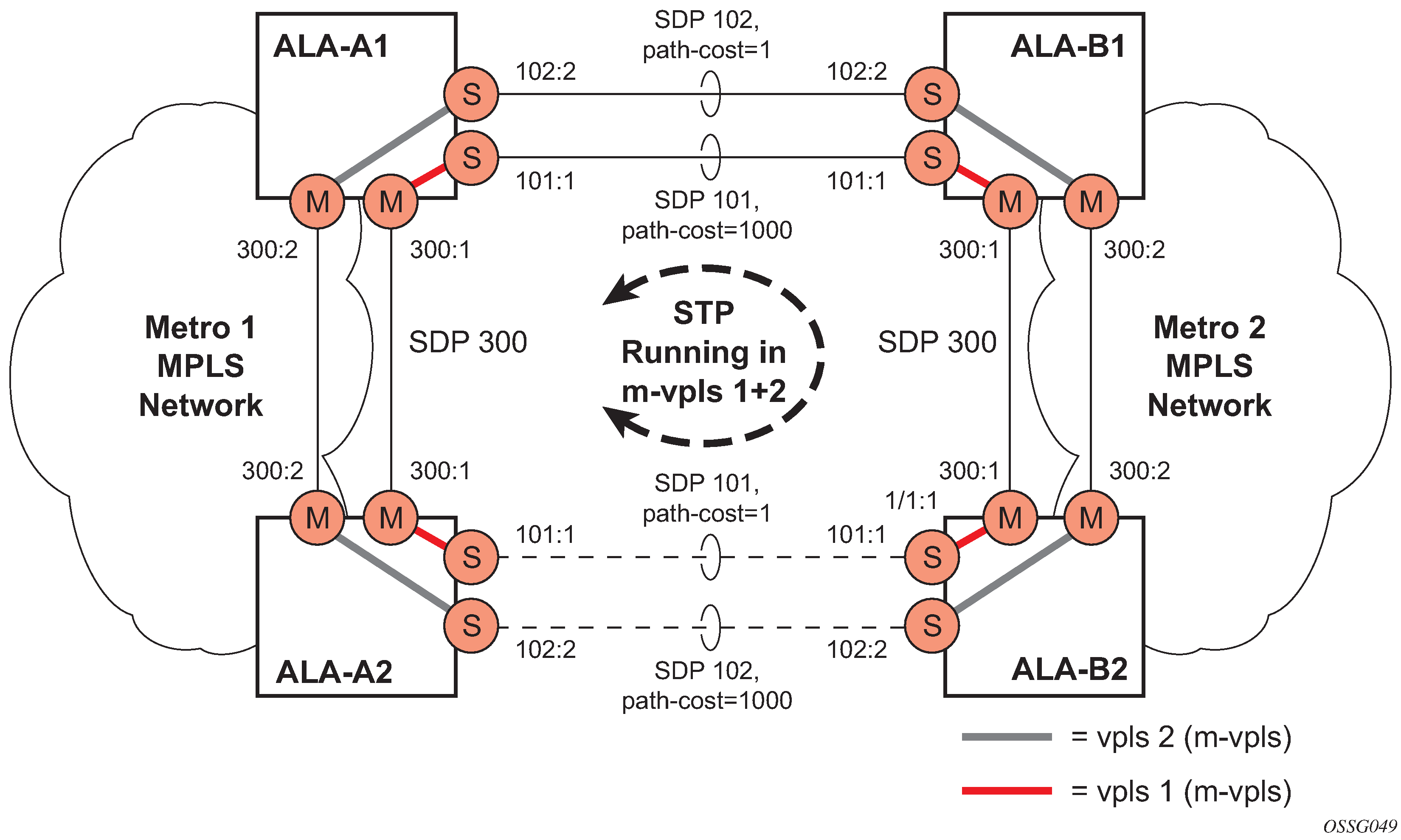With the concept of management VPLS, it is possible to load balance the user VPLS services across the two protecting nodes. This is done by creating two management VPLS instances, where both instances have different active QinQ spokes (by changing the STP path-cost). When user VPLS services are associated with either of the two management VPLS services, the traffic is split across the two QinQ spokes. Load balancing can be achieved in both the SAP protection and spoke-SDP protection scenarios.
Figure 1 shows an example configuration for load balancing across two protected VPLS spoke-SDPs.

Use the following CLI syntax to create load balancing across two management VPLS instances.
CLI syntax:
config>service# sdp sdp-id mpls create
far-end ip-address
lsp lsp-name
no shutdown
CLI syntax:
vpls service-id customer customer-id [m-vpls] create
— description description-string
— mesh-sdp sdp-id:vc-id create
— spoke-sdp sdp-id:vc-id create
— stp
— path-cost
— stp
— no shutdown
The following example shows the VPLS configuration on ALA-A1 (upper left, IP address 10.0.0.10):
*A:ALA-A1>config>service# info
----------------------------------------------
...
sdp 101 mpls create
far-end 10.0.0.30
lsp "1toALA-B1"
no shutdown
exit
sdp 102 mpls create
far-end 10.0.0.30
lsp "2toALA-B1"
no shutdown
exit
...
vpls 101 customer 1 m-vpls create
spoke-sdp 101:1 create
stp
path-cost 1
exit
exit
mesh-sdp 300:1 create
exit
stp
exit
no shutdown
exit
vpls 102 customer 1 m-vpls create
spoke-sdp 102:2 create
stp
path-cost 1000
exit
exit
mesh-sdp 300:2 create
exit
stp
exit
no shutdown
exit
...
----------------------------------------------
*A:ALA-A1>config>service#
The following example shows the VPLS configuration on ALA-A2 (lower left, IP address 10.0.0.20):
*A:ALA-A2>config>service# info
----------------------------------------------
...
sdp 101 mpls create
far-end 10.0.0.40
lsp "1toALA-B2"
no shutdown
exit
sdp 102 mpls create
far-end 10.0.0.40
lsp "2toALA-B2"
no shutdown
exit
...
vpls 101 customer 1 m-vpls create
spoke-sdp 101:1 create
stp
path-cost 1000
exit
exit
mesh-sdp 300:1 create
exit
stp
exit
no shutdown
exit
vpls 102 customer 1 m-vpls create
spoke-sdp 102:2 create
stp
path-cost 1
exit
exit
mesh-sdp 300:2 create
exit
stp
exit
no shutdown
exit
...
----------------------------------------------
*A:ALA-A2>config>service#
The following example shows the VPLS configuration on ALA-A3 (upper right, IP address 10.0.0.30):
*A:ALA-A1>config>service# info
----------------------------------------------
...
sdp 101 mpls create
far-end 10.0.0.10
lsp "1toALA-A1"
no shutdown
exit
sdp 102 mpls create
far-end 10.0.0.10
lsp "2toALA-A1"
no shutdown
exit
...
vpls 101 customer 1 m-vpls create
spoke-sdp 101:1 create
stp
path-cost 1
exit
exit
mesh-sdp 300:1 create
exit
stp
exit
no shutdown
exit
vpls 102 customer 1 m-vpls create
spoke-sdp 102:2 create
stp
path-cost 1000
exit
exit
mesh-sdp 300:2 create
exit
stp
exit
no shutdown
exit
...
----------------------------------------------
*A:ALA-A1>config>service#
The following example shows the VPLS configuration on ALA-A4 (lower right, IP address 10.0.0.40):
*A:ALA-A2>config>service# info
----------------------------------------------
...
sdp 101 mpls create
far-end 10.0.0.20
lsp "1toALA-B2"
no shutdown
exit
sdp 102 mpls create
far-end 10.0.0.20
lsp "2toALA-B2"
no shutdown
exit
...
vpls 101 customer 1 m-vpls create
spoke-sdp 101:1 create
stp
path-cost 1000
exit
exit
mesh-sdp 300:1 create
exit
stp
exit
no shutdown
exit
vpls 102 customer 1 m-vpls create
spoke-sdp 102:2 create
stp
path-cost 1
exit
exit
mesh-sdp 300:2 create
exit
stp
exit
no shutdown
exit
...
----------------------------------------------
*A:ALA-A2>config>service#